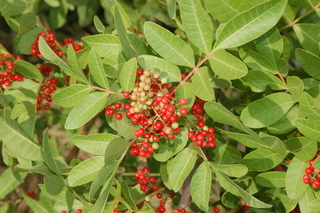Schinus molle (Peruvian pepper , also known as American pepper, Peruvian peppertree, escobilla, false pepper, molle del Peru, pepper tree, peppercorn tree, Californian pepper tree, pirul and Peruvian mastic) is an evergreen tree that grows to 15 meters (50 feet). It is native to the Peruvian Andes. The bright pink fruits of Schinus molle are often sold as "pink peppercorns" although S. molle is unrelated to true pepper (Piper nigrum). The tree is host to Bombycomorpha bifascia, known as the Pepper-tree moth.
Schinus molle is a quick growing evergreen tree that grows 15 meters (50 feet) tall and 5–10 meters (16–33 feet) wide. It is the largest of all Schinus species and potentially the longest lived. The upper branches of the tree tend to droop. The tree's pinnately compound leaves measure 8–25 cm long × 4–9 cm wide and are made up of 19-41 alternate leaflets. Male and female flowers occur on separate plants (dioecious).[3] Flowers are small, white and borne profusely in panicles at the ends of the drooping branches. The fruit are 5–7 mm diameter round drupes with woody seeds that turn from green to red, pink or purplish,carried in dense clusters of hundreds of berries that can be present year-round. The rough grayish bark is twisted and drips sap. The bark, leaves and berries are aromatic when crushed.
S. molle is native to the arid zone of Northern South America and Peru's Andean deserts, and goes to Central Argentina and Central Chile. It has, however, become widely naturalized around the world where it has been planted, known for its strong wood used for saddles. It was part of the Spanish colonies' supply sources for saddles; as an ornamental and for spice production. S. molle is a drought tolerant, long-lived, hardy evergreen species that has become a serious invasive weed internationally.
In South Africa, for example, S. molle has invaded savanna and grasslands and become naturalised along drainage lines and roadsides in semi-desert. It is also invasive throughout much of Australia in a range of habitats from grasslands to dry open forest and coastal areas, as well as railway sidings and abandoned farms. In the United States, either S. molle or its close relative Schinus terebinthifolius is particularly invasive in Florida and Hawaii, and can also be found crowding out native vegetation in southern Arizona, southern California, Texas, Louisiana and Puerto Rico.
Extracts of S. molle have been used as a flavor in drinks and syrups.
In traditional medicine, S. molle was used in treating a variety of wounds and infections due to its antibacterial and antiseptic properti8es. It has also been used as an antidepressant and diuretic, and for toothache, rheumatism and menstrual disorders, with recent studies in mice providing possible support for its antidepressant effects. It has also been speculated that S. molle's insecticidal properties make it a good candidate for use as an alternative to synthetic chemicals in pest control.
Fresh green leaves in bunches are used shamanically in Mesoamerican traditional ceremonies for cleansings and blessings.
